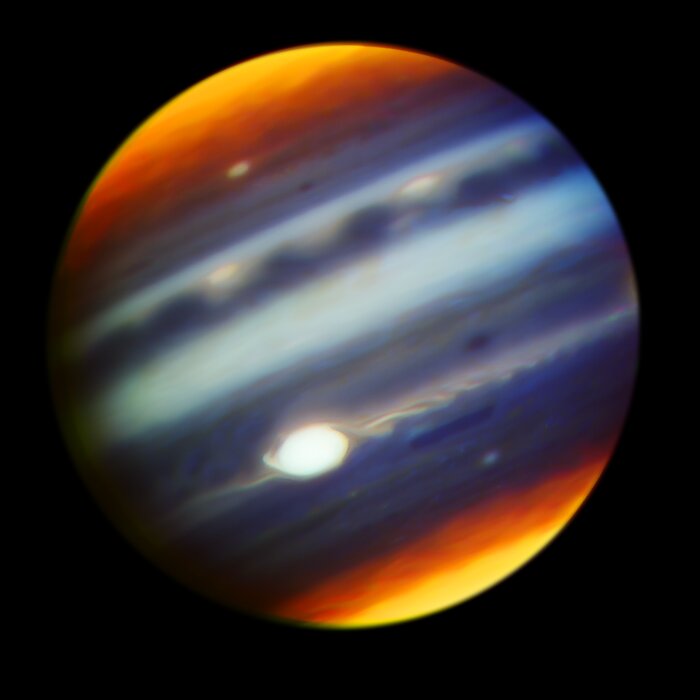Striking Gemini Images Point Juno Spacecraft Toward Discovery
A composite color infrared image of Jupiter reveals haze particles over a range of altitudes, as seen in reflected sunlight. The image was taken using the Gemini North telescope with the Near-InfraRed Imager (NIRI) on May 18, 2017, one day before the Juno mission’s sixth close passage (“perijove”) of the planet. The color filters cover wavelengths between 1.69 to 2.275 microns and are sensitive to pressures of 10 millibars to 2 bars. The Great Red Spot (GRS) appears as the brightest (white) region at these wavelengths, which are primarily sensitive to high-altitude clouds and hazes near and above the top of Jupiter’s convective region – revealing that the GRS is one of the highest-altitude features in Jupiter’s atmosphere. The features that appear yellow/orange at Jupiter’s poles arise from the reflection of sunlight from high-altitude hazes that are the products of auroral-related chemistry in the planet’s upper stratosphere. Narrow spiral streaks that appear to lead into it or out of it from surrounding regions probably represent atmospheric features being stretched by the intense winds within the GRS, such as the hook-like structure on its western edge (left side). Some are being swept off its eastern edge (right side) and into an extensive wave-like flow pattern; and there is even a trace of flow from its north. Other features near the GRS include the dark block and dark oval to the south and the north of the eastern flow pattern, respectively, indicating a lower density of cloud and haze particles in those locations. Both are long-lived cyclonic circulations, rotating clockwise - in the opposite direction as the counterclockwise rotation of the GRS. A prominent wave pattern is evident north of the equator, along with two bright ovals; these are anticyclones that appeared in January. Both the wave pattern and the ovals may be associated with an impressive upsurge in stormy activity that has been observed in these latitudes this year. Another bright anticyclonic oval is seen further north. Juno may pass over these ovals during its July 11 closest approach. High hazes are evident over both polar regions with much spatial structure that has never been seen quite so clearly in ground-based images, with substantial variability in their spatial structure. The central wavelengths and colors assigned to the filters are:1.69 microns (blue), 2.045 microns (cyan), 2.169 microns (green), 2.124 microns (yellow), and 2.275 microns (red).
Credit:Gemini Observatory/AURA/NSF/JPL-Caltech/NASA
About the Image
| Id: | gemini1706a |
| Type: | Planetary |
| Release date: | June 30, 2017 |
| Related releases: | gemini1706 |
| Size: | 965 x 965 px |
About the Object
| Name: | Jupiter |
| Category: | Solar System |
Wallpapers
Colors & filters
| Band | Tele-scope |
|---|---|
| Gemini North NIRI |
